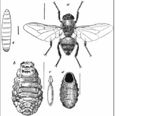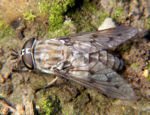Myiasis Producing Flies
| This article is still under construction. |
|
|
Introduction
Myiasis is the parasitism of living animals by dipteran larvae. Myiasis can be oligatory or facultative (optional) and is described as cutaneous, nasal or somatic.
Oestridae
- The larvae of Oestridae spp. are obligatory parasites
- The three important species of veterinary interest are Hypoderma, Oestrus and Gasterophilus
Hypoderma spp.
- Also known as warble flies
- Important cattle parasites
- Also parasitise horses, small ruminants and sometimes humans
- The two main species in cattle are H. bovis and H. lineatum
- H. diana parasitises deer
- Infestation is largely confined to the Northern Hemisphere
Recognition
- Large 13-15mm long
- Similar to bumble bees in appearance
- Yellow abdomen
- Band of black hairs
- One pair of wings
Life Cycle
- Adult flies emerge on warm, sunny days between June and August
- White eggs are laid around the belly and legs of the animal
- Eggs are attached to hairs by cement and a small terminal clasp
- H. lineatum lays a whole row of eggs as it approaches the animal stealthily
- H. bovis only deposits a single egg before the animal runs away ('gadding) as it makes a loud buzzing noise
- The adult lives for 3 weeks
- Females can lay several hundred eggs in their life
- A few days after eggs are laid, larvae emerge and crawl down the hairs into the hair follicles
- Larvae penetrate the skin through wounds made by biting flies
- Larvae migrate through the subcutaneous tissue towards the diaphragm
- Enzymatic secretions and mouth hooks aids larval migration
- After 3 months larvae reach winter resting sites where they remain from November to Feburary/March whilst moulting to the L2 stage
- Epidural fat in the spinal canal for H. bovis
- Wall of the oesophagus for H. lineatum
- Larvae then migrate back to the subcutis along the midline of the back where they bore a breathing hole through the skin and moult to the L3 stage
- Larvae are palpable as distinct swellings called warbles
- L3 larvae emerge after 4-10 weeks where they fall to the ground and pupate under loose vegetation
- Adult flies emerge from the pupa after one month where they copulate, lay eggs and die within two weeks
- H. lineatum are on the wing 6-8 weeks before H. bovis
- There is only one generation of warble flies per year
Pathogenesis
- Causes myositis
- Production losses
- Condemnation and down-grading of hides
- Reduced milk yield and reduced weight gain
- Injury from stock panic
- Trimmed meat losses from H. lineatum
- 'Butcher's Jelly' around warbles which is green due to mass eosinophil attraction
- Paraplegia resulting from:
- Toxin release
- Pressure on the spinal cord (H. bovis)
- Bloat from pressue on the oesophageal wall (H. lineatum)
Control
- Total eradication should be aimed for
- Old methods include popping out warbles
- But could lead to anaphylactic shock
- Ectoparasiticides
- Systemic organophosphorus insecticides in pour-on formula
- Avermectins and milbemycins in pour-on and injectible formulations
- Timing is crucial for treatment
- Larvae residing in winter resting sites, if killed, can lead to bloat and paraplegia
- It is safe to treat in the autumn before larvae reach their winter resting sites and in the spring when the warbles have migrated to the midline of the back
- Ivermectin can be given at any time without risking host infection as larval antigen is released much slower
Legislation in the UK
- 'Warble Fly Order 1978' requires all clinically affected animals to be treated
- Notifiable disease
- 'Warble Fly Infected Area Order 1983'
- For more information on the warble fly orders, see here
Oestrus ovis
- Also known as the sheep nasal bot fly
- Larvae parasitise the nasal chambers of sheep and goats
- Found in most sheep rearing areas of the world
Recognition
- 13-15mm long
- Grey colouring
- Black spots on abdomen
- Clear wings
- Larvae have distinct black bands on each body segment
Life Cycle
- Larvae are squirted into the nostils of sheep in a jet of liquid
- The larvae crawl caudally into the nasal cavity and feed on the nasal mucosa and mature before returning to the nostrils
- Larval development takes up to two months
- Larvae can overwinter in the nasal cavity if deposited late in the summer
- Once the larvae have developed they are sneezed out and pupate on the ground
- The adult fly emerges one months later
- Adult flies only live for 2-3 weeks
Pathogenesis
- Adult flies can annoyance
- Interrupts feeding
- Leads to a decreased weight gain
- Larvae cause nasal irritation, nasal discharge and sneezing
- Irritate the nasal mucosa with oral hooks and spines causing a viscous exudate to be produced from which they feed
- Heavy infestations lead to erosion of the bones in the sinuses (turbinate bones)
- Penetration of the brain leads to false gid (high stepping gait and incoordination)
Control
- Systemic insecticides can be used in heavy infestations
- In warmer countries, strategic prophylactic treatment can be used
Gasterophilus spp.
- Also known as the horse bot fly
- Obligate parasites of equids
- Spend most of lifecycle in equine stomach
- Cause little pathogenesic significance
- Three important species (in the UK)
- G. intestinalis which is the most common
- G. nasalis
- G. haemorrhoidalis which is rare
- Two other important veterinary species
- G. nigricornis
- G. inermis
Recognition
- Medium to large flies at 10-20mm long
- Look similar to drone bumble bees
- Body covered with dense yellow hair
- Dark coloured hairs produce a banding pattern
- Clear wings with brown patches
Life Cycle
- Adults are most active in late summer
- Eggs hatch spontaneously or are stimulated to hatch through an increase in warmth and moisture from the animal self-grooming
- G. intestinalis
- Creamy-white eggs
- 1-2mm in length
- Eggs laid in the hair of the shoulders and fore legs
- G. nasalis
- Eggs laid in the intermandibular area
- G. intestinalis
- G. haemorrhoidalis
- Eggs laid around the lips
- Larvae crawl into the mouth and penetrate the tissues of the buccal mucosa which takes a few weeks
- Larvae then emerge and are swallowed
- Larvae pass into the stomach and attach to the gastric mucosa
- Larvae are now known as bots
- Each species attaches to a specific part of the stomach
- G. intestinalis attaches to the cardiac region
- G. nasalis attaches to the pylorus
- After 10-12 months in the stomach, the larvae detach and are passed out in the faeces
- G. haemorrhoidalis attaches to the rectal mucosa before being passed out
- Larvae pupate on the ground
- Adults hatch after 1-2 months and survive for a few days up to two weeks
- Adults have non-functional mouthparts so cannot feed
- There is only one generation per year in temperate regions of the world
Pathogenesis
- Adult cause annoyance when egg laying
- Disturbance and panic can ensue
- Larvae cause a marked inflammatory reaction when attached to the gastric mucosa
- Ring like thickening around the base of each attached larvae
- Large numbes of larvae may interfere with the passage of food and action of the sphincters
- G. haemorrhoidalis can cause mild irritation to the rectal wall
- Host reaction to larvae in the mouth is minimal
Control
- Treatment of horses with insecticides over winter
- Breaks the life cycle as all the population are present as bots in the stomach
- If eggs are present in late summer, the horse's coat can be sponged with an insecticide
- Stimulates hatching
- Kills larvae
Dermatobia hominis
- Also called the human bot fly
- Larvae are important parasites of both humans and animals
- Specifically found in South America
Recongition
- Adult can grow up to 25mm in length
- Similar to Calliphora in appearance
- Blue/black
- Yellow/orange head and legs
- Larvae are dinstincive as they taper towards the posterior end
Life Cycle
- Eggs laid on blood sucking flies
- E.g. On mosquitos, which hatch when the mosquito next lands on a warm blooded animal
- Larvae penetrate skin causing painful swellings
- Larvae emerge after 35-42 days and fall to ground to pupate
- 4 month life cycle
Pathogenesis
- In humans, the larvae are msot often found in swellings on the head and limbs
- Larvae cause painful swellings and distress to cattle
- Larvae cause production losses
- Larvae exit wounds can increase the prevalence of attack by other myiasis flies
Calliphoridae
Recongition
Life Cycle
Pathogenesis
Control
Screw Worm Myiasis
Recongition
Life Cycle
Pathogenesis
Control
Wohlfahrtia sp.
Recongition
Life Cycle
Pathogenesis
Control

